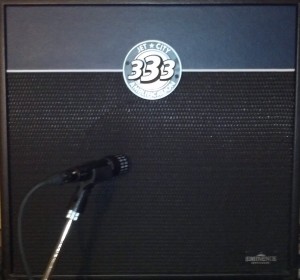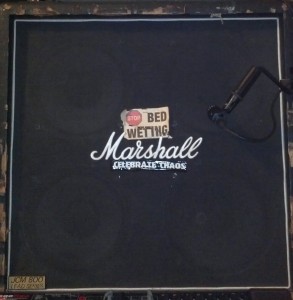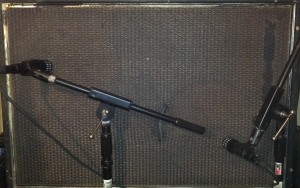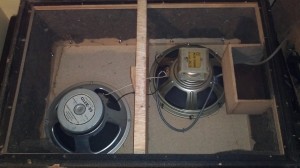Getting awesome guitar tones recorded in any setting is not as hard as you might think. After recording a huge number of different guitarists including myself over the last 20 years, I have found that great results can be achieved in almost any space.
While there are no rules when setting out to record the golden tone, these are some things that my years have taught me and in coming installments of this series I’ll be sharing more aspects of getting the tones you’re looking for in the home setting and in general.
1- Get it right at the source, or Garbage in = Garbage out
If you aren’t happy with your guitar sound coming out of your amp, it’s not very likely that you’ll like it much after spending an hour trying to “fix it” after the fact. One piece of advice I often give is to set your amp so that it sounds good to you in the room. Then, and use caution, bring your head down to speaker level and listen. This is what the microphone “hears”. In most cases, after I’ve had a guitarist set their amp settings to their liking, I’ll end up tweaking the amp’s settings by bringing down the level of the gain a bit and rolling off the high end a bit while boosting the mids slightly. What results is getting the same sound they’re happy with in the room translated through the mic. This is especially true when “close micing”, or putting a mic (typically of the dynamic nature) directly in front of a speaker. Sometimes by taking these steps you’ll be able to improve your sound to more of your liking.
2- Speakers, your amp’s mouth.
There are huge differences in the sound of different speakers and even the cabinets they are enclosed in. I have seen many people buy an awesome expensive amp and then turn around and buy the cheapest speaker cabinet they can find to save money. In my opinion, this is the equivalent of buying a new pair of glasses and before looking through them, smearing dirt on the lenses. Always remember that without decent speakers you won’t be hearing your amp’s true voice. I have also experienced situations where the same exact speakers sound completely different when placed in different cabinets.
For this installment, let’s take a listen to three different speaker cabinets with four different speakers used with the same amplifier and settings.
Here are the culprits:
Jet City 1×12 closed back cabinet loaded with a custom voiced Eminence speaker.
Early 80’s Marshall JCM800 4×12 closed back cabinet loaded with Celestion G12T-75 speakers. This has been my main cabinet on stage for many years and definitely has the road scars to prove it!
And for a bit of history, an early 60’s Ace Tone (predecessor to Roland) 2×12 closed back cabinet loaded with an original Ace Tone speaker and a Celestion G12K-85 speaker. (I acquired this cabinet with one of the original speakers replaced with a ripped Radio Shack speaker that I swapped out for the Celestion that I had lying around.)
All examples recorded using a Jet City JCA20H 20watt head loaded with Groove Tube 12AX7’s and JJ Electronics EL84’s. For the “metal” examples a T Rex Crunchy Frog overdrive pedal and Decimator noise gate are added to the signal chain before the amp.
The guitar used is a 1978 Gibson Les Paul with a Burstbucker Pro pickup in bridge position and TonePros bridge modifications.
All examples were recorded with Audix I5 mics placed directly on the speaker grill at a 45 degree angle and run straight into a Roland Octa-Capture with no signal processing and no processing within SONAR X1 Producer Expanded.
After listening to the examples, you can hear that every speaker has a different voice even though no settings on the amp were changed at all. Factors like the size and wattage of a speaker and the size and material of the enclosure it’s in will make vast differences in the sound of the amp. So when you’re looking at speakers, experiment with different types using your amp of choice to find the voice you like!
To get more tips on recording and using SONAR, visit CakeTV.






